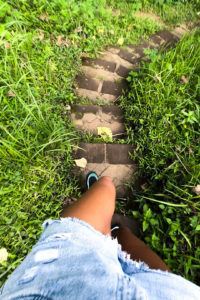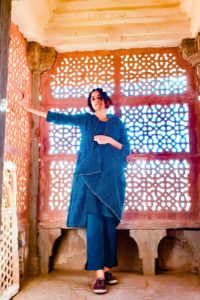Joshua Tree National Park is a favorite of SoCal residents, especially from Los Angeles. Luckily it is also one of the most beautiful national parks near LA.
This incredibly famous national park has one of the most distinctive landscapes you can find in California. The Mojave and Colorado ecosystems clash in a wondrous way, creating a landscape of Joshua trees, barren rock formations and Colorado sand trails. The valley has gorgeous wildflowers, sand dunes and granite monoliths to discover.
Joshua Tree is extremely loved by the residents of LA who regularly make weekends trips to this California National Park. It’s close proximity makes it the ideal road trip destination.
The park does not have any restaurants, accommodations or shops but has plenty of campgrounds for camping. The campgrounds costs $30 per vehicle for a 7 day pass which is well worth the price.
The top things to do in Joshua Tree include rock climbing, walking the gorgeous landscape and gazing at the clear skies at night.
The best family friendly trails in the park are the Bajada Trail or the Keys View Trail. For a unique attraction check out the Skull Rock near Jumbo Rocks Campground.
If you only want to visit the national park and not stay the night (completely understandable, I am not a huge fan of camping myself, there is a reason hot showers were invented) you can stay the night at Palm Springs just 50 miles away for an awesome weekend getaway.
The town of Palm Springs is absolutely gorgeous and deserves a whole blog to itself. You can make a Joshua Tree and Palm Springs road trip which is what many people regularly do.
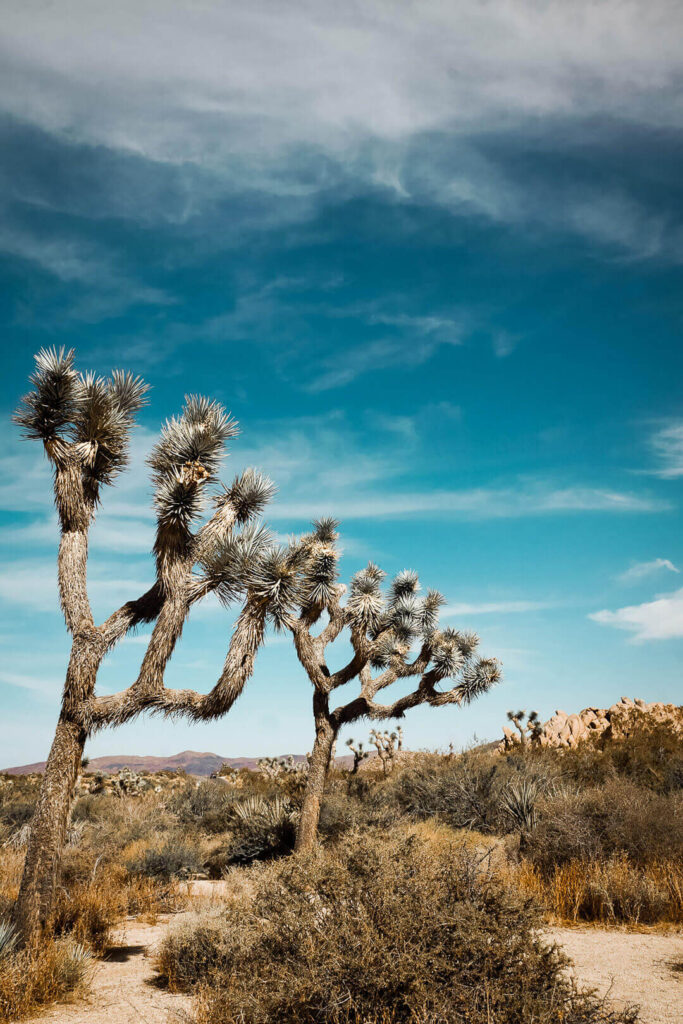
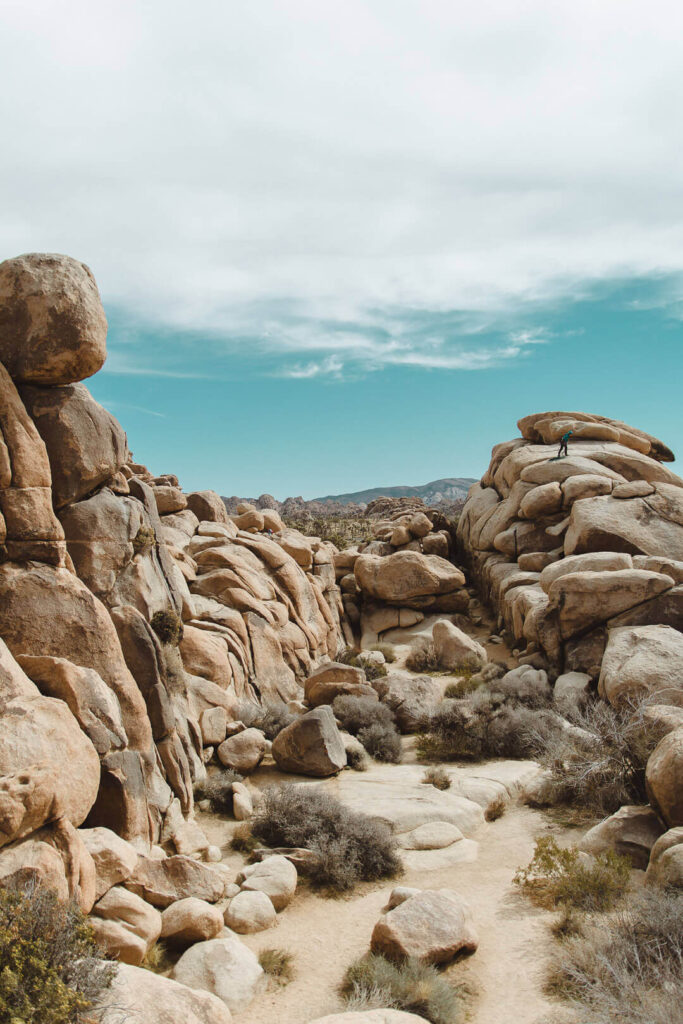
Top tips before visiting Joshua Tree
- There is no call service in most parts of the national park. You should download the map of the hikes and keep it handy so you don’t get lost. Also keep a map of the road system handy in case you lose service on the road.
- America the Beautiful pass for $80 is a great investment and allows access to 2000 sites nationwide including Joshua Tree National Park.
- October – May is peak season and most campgrounds fill up on Friday morning. Even parking lots on famous trailheads fill up very quickly.
- March – May is wildflower and peak climbing season.
- Late April – late July is the best time for stargazing. You can find a list of meteor showers HERE.
- Pets are not allowed on trails. They are allowed on campgrounds and RVs but make sure they are not on trails for their own safety and the protection of the ecosystem.
- There aren’t many water taps in the park so it’s a good idea to carry a lot of drinking water with you.
- Campgrounds are very popular and fill up by Friday morning. You can either get a reservation in advance or get here really really early.
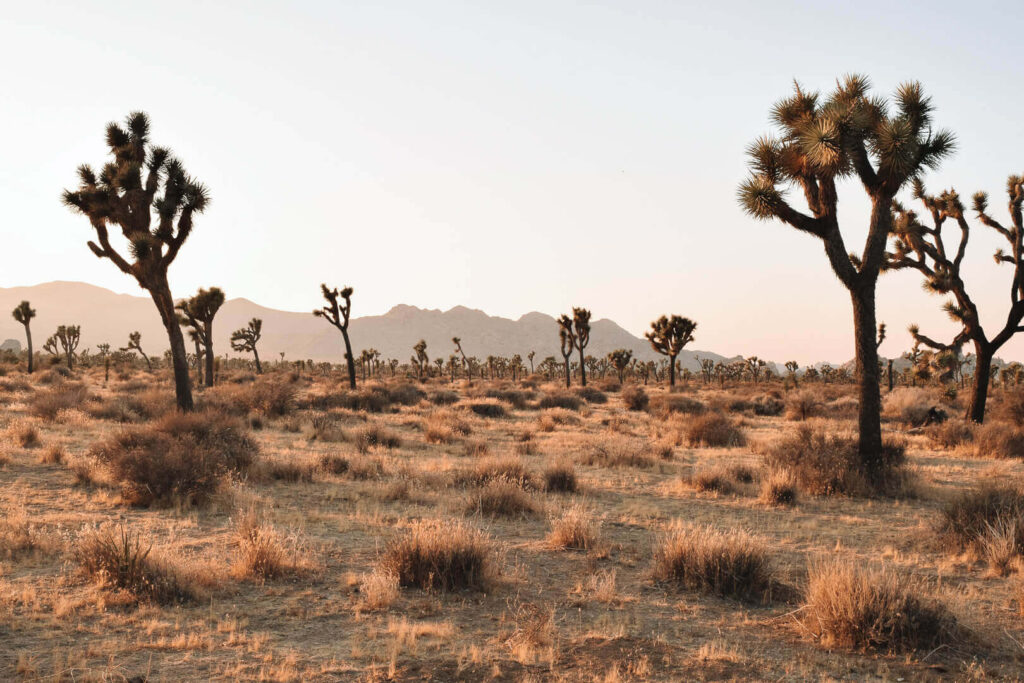
What to bring
- Drinking water – There aren’t many water taps in the park so it’s a good idea to carry a lot of drinking water with you.
- Warm clothes – The temperature in the desert drops down a lot at night. If you are camping in the park you will need a lot of warm clothes.
- Sunscreen – The sun is relentless in the desert and you will turn into a cherry tomato if you don’t use sunscreen.
- Walking shoes – The rocky and prickly terrain of Joshua Tree requires some good walking shoes. Flip flops and flimsy shoes won’t do.
Distance to nearest cities
- Palm Springs – 37.5 miles, 47m
- Los Angeles – 131 miles, 2h17m
- Santa Ana – 117 miles, 2h
- Long Beach – 138 miles, 2h22m
- San Diego – 164 miles, 2h37m
- Las Vegas – 187 miles, 3h
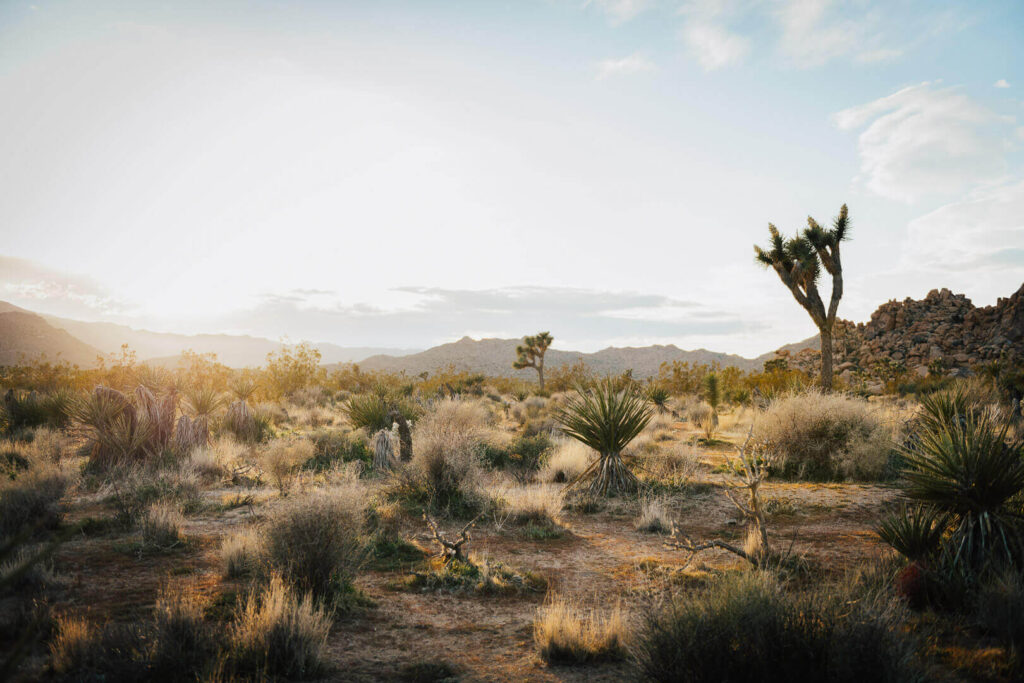
Things to do in Joshua Tree National Park
1. Hidden Valley Nature Trail
This is one of the best and most accessible hikes in Joshua Tree. You can start your foray into the national park by getting acclimated at this trail.
Hidden Valley Trail is a 1 mile loop that encompasses all of the features of Joshua Tree you might hope to see. It has plaques along the routes to educate you about the ecosystem of Joshua Tree. The loop is very easy to do for those that are traveling with kids.
The trail heads into a bowl like rock formation that is rumored to have been used by cattle rustlers to hide their cattle. On this trail you can also find the rock formation lovingly known as the Great Burrito which is popular amongst climbers in the park.
On the opposite side of the parking lot at the trailhead is the Hidden Valley Picnic Area which has scenic views and a lot of cute Joshua Trees. This is a great place for a picnic lunch after your hike.
2. Keys View
Keys view is a lookout point with unobstructed views over the Coachella Valley. It is the highest point in the park with an elevation of 5000 feet.
You can drive up Keys Road to the viewpoint at the top of San Bernardino Mountains. You can catch the views from the parking lot or walk a short trail to the overlook point.
At Keys Point you can actually see the San Andreas fault line, the town of Palm Springs, the Salton Sea and even all the way to Mexico if it’s a clear day. The 2 mountains to spot from this view point are Mount San Jacinto near Palm Springs, and Mount Gorgonio on its right.
The best views are at sunset with hues of red and orange lighting up the sky. I live in LA and even the sunsets here never fail to wow me. Sunsets also attract a lot of people so for a quieter time, sunrises are also spectacular.
3. Barker Dam Nature Trail
The Barker Dam Nature Trail is a 1.3 miles trail around the Barker Dam. The dam was built by cattle ranchers in the 20th century and makes for a pleasant hike.
The trail is one of the best for bird watching since the birds are attracted to the water reservoir. Bighorn sheep are also regulars to the dam and you might end up spotting one. One of the most unique things to do on this trail are to spot the petroglyphs in stone – keep a lookout for the signs that point to these!
To get to this trail you will need to follow the signs for Barker Dam on Park Boulevard. There is a parking lot right by the trailhead.
You can walk the trail to the remnants of a water tank at the far ends of the dam and turn back which is what most people do. But I recommend you continue on beyond the dam. The trail beyond the dam has some gorgeous scenery and large Joshua trees which adds to the beauty of the hike.
4. Camping
Of course you can’t go to Joshua Tree and not spend at least one day camping. Joshua Tree National Park is absolutely stunning and camping amongst the Joshua trees and the desert rocks is an otherworldly experience.
Joshua Tree has several campgrounds set in locations that are both convenient and beautiful. Campgrounds are open from September through May and closed in the summer months. The campgrounds are set up for smaller RVs, tents and camp trailers. There is no jumbo RV camping.
To rent an RV check out Outdoorsy which is great for RV rentals.
You can risk camping at a first come first serve campground like Hidden Valley Campground where people set up by Friday morning for the weekend. If you prefer to have a reservation then the best choice is the Jumbo Rocks Campground. Black Rock Campground and Cottonwood Campground also have additional amenities like water and flush toilets which other campsites don’t.
The best thing about camping at Joshua Tree are the night skies. These are especially beautiful without the light pollution. If you go during one of the meteor shower dates you can see these with amazing clarity.
5. Cholla Cactus Garden
The Cholla Cactus is a native plant to Joshua Tree. It is found scattered around the national park amidst other bush. At Cholla Cactus Garden the teddy bear chollas are densely packed within a small area. It’s a naturally occurring garden that nature lovers will enjoy.
The flat trail is just 0.25 miles long and an easy hike. The best time to visit is in the golden hour when the plants look lovely in the yellow light. The Cholla Cactus blooms in March and April.
To get to the Cholla Cactus Garden you will need to drive 12 miles into the Pinto Basin from the north entrance of Joshua Tree National Park. It is on the road to Cottonwood Spring beyond the Belle and White Tank campgrounds.

6. Skull Rock
The iconic Skull Rock, as is obvious by the name, is one of the rock formations in Joshua Tree that is shaped like a skull. Something out of an Indiana Jones movie, Skull Rock draws a lot of attention from visitors.
Skull Rock can be viewed from Park Boulevard since it sits right beside the road but scramble up the rock for a cool picture. You can also hike to and back from Skull Rock from the Jumbo Rocks Campground on a 1.7 mile loop trail.
This part of Joshua Tree has some very interesting rock formations and trails. Split Rock, also along Park Boulevard is another famous rock formation. Across the road from Skull Rock is a secluded 1.7 mile hiking trail that would be interesting to those that like adventure.
7. Rock Climbing
Climbing and bouldering is one of the most fun things to do in Joshua Tree. The incredible rock formations in the national park attract climbers of all levels to go climbing.
Joshua Tree has somewhere around 8000 climbing routes and hundreds of rock formations. You can find information and maps of the climbing routes at the visitor centers.
The main areas where you can find climbers are Hidden Valley and other sites at the west end of the park. If you are a novice climber you can take climbing lessons from a local. Make sure the individual is authorized to train inside the park. These lessons are a lot of fun!
8. Ryan Mountain Hike
The hike up Ryan Mountain is a strenuous 3 mile hike with an elevation gain of 1000 feet. At the top you have 360 degree views over the park all the way to the Little San Bernardino Mountains. The views are absolutely gorgeous. If you reach here before sunrise you can catch the most amazing view of the sun rising above the horizon.
The trail is strenuous and might be daunting to first timers. It is steep and there are stone steps carved into the rocks. The hike does not have any shade so the best time to do it is early in the morning.
To reach the trailhead for Ryan Mountain Hike, take the Ryan Mountain turnoff from Park Boulevard. There is a parking lot at the trailhead. Be sure to reach here early to secure a spot.
9. Keys Ranch Tour
While admiring the natural beauty of Joshua Tree National Park people often forget the history that this area holds. One of the best ways to discover the history of Joshua Tree is to take a guided tour of the Keys Ranch.
Bill Keys was one of the early settlers in the region and built the ranch. The property has a house, schoolhouse, store and a workshop. It is considered a National Historic Register Site. You can only visit the site on ranger-led guided tours.
The tours last for 90 minutes and dive into the colorful history of Bill Keys. You get to learn how the ingenuity of the family helped them survive the harsh desert and become the first settlers here. The tours are incredibly popular and sell out in advance. You can book your tickets 60 days in advance which is recommended.
10. Cottonwood Spring Oasis
Cottonwood Spring is a little palm oasis in the desert that attracts many birds and animals native to the region. The spring originated as a result of an earthquake many years ago. It has since become the source of water for the Cahuilla natives, miners, and other prospectors that have passed through Joshua Tree over the years. You can still see some gold processing equipment nearby.
This is also one of the best places in the park to watch the birds. Some of them include the black-throated sparrow, the roadrunner, the Blue Grosbeak and the quail.
The landscape is lush and green, in stark contrast to the rest of the national park. There is also a hike nearby that leads to a dry fall. If you visit during a wet year you may see water flowing down the falls.
One of the most famous hikes from Cottonwood Spring Oasis is the 3 miles Mastodon Peak Loop. You can see an old mill and an old mine on this trail. There is also a longer 8 mile loop trail to the Lost Palms Oasis which is another beautiful oasis to visit.
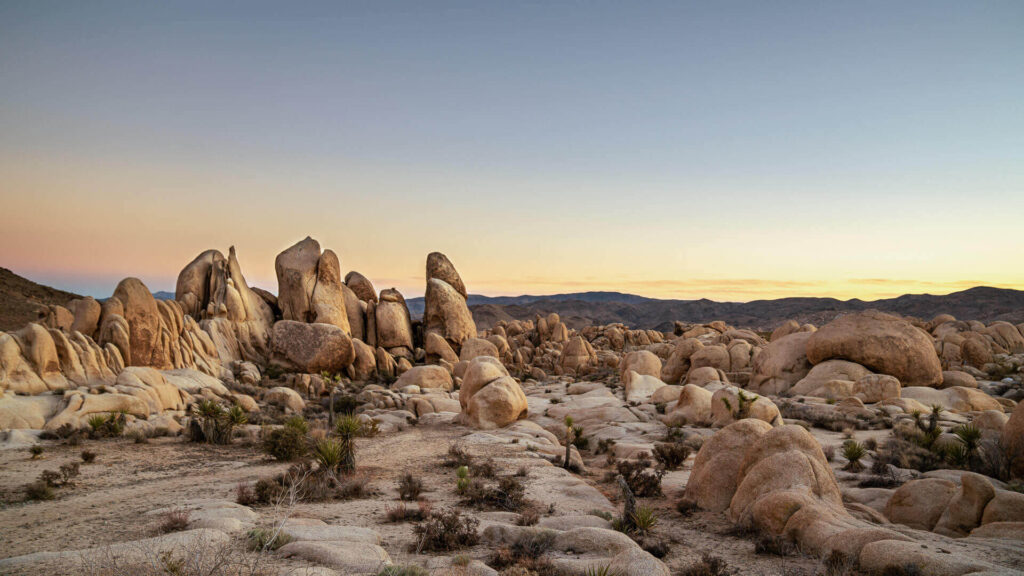
11. Wildflowers
The blooming of the Joshua Tree wildflowers is one of the most stunning sites in the national park. During years of ample bloom you can see flowers of reds, yellows, purples and blues all across the landscape.
Some of the most gorgeous Californian flowers thrive at Joshua Tree. The pretty Desert Bluebells, delicately colored Mojave Aster, the bright Chuparosa and my favorite, Booth’s Evening Primrose are a few flowers you can expect to see during the bloom. Checkout all the flowers at Joshua Tree at this awesome list at iNaturalist.
The wildflowers are very delicate and only last for a few weeks before wilting away in the heat. The bloom starts in February in the lower elevations 1000-3000ft and lasts up until June at the higher elevations 3000-5000ft. Due to the harsh climate of the desert you will only see wildflowers after a winter that has had plenty of rain.
Unfortunately the winter of 2020-2021 was not very wet and the park officials do not expect a large bloom this year. The last super bloom was seen after the very rainy season of 2016 which coincided with the El Nino. Here’s hoping for the next one!
12. Bird Watching
The trails with water at Joshua Tree are one of the finest places for bird watching in the park. The different species of birds are all attracted to these sources of water.
Birds like the roadrunner, phainopepla, mockingbird, verdin, cactus wren, rock wren, morning dove, Le Conte’s thrasher and Gambel’s quail and year round residents of Joshua Tree. The park also has migratory birds that fly into Joshua Tree for the warm summer. Some of them are the cedar waxwing, American robin, hermit thrush and dark eyed junco.
Another interesting group of birds are the hawks which are abundant here. Some of them are the red tailed hawk, American kestrel, Cooper’s haw, Swainson’s hawk, rough-legged hawk amongst others.
Some of the best areas for bird watching in the park are the Cottonwood Oasis, the Oasis of Mara, Barker Dam, Lost Palms Oasis and 49 Palms Oasis. The best way to birdwatch is to take a pair of binoculars, get to the trails at sunrise and take a checklist with you to mark how many birds you could see.
13. Horse riding
Horse riding in Joshua Tree is one of the most exciting things to do. There are many horse trails in Joshua Tree that let you explore the beautiful national park. Knob Hill Ranch, Cottonwood Canyon Ranch and Crazy Horse Ranch are a few really good ranches that provided good quality rides.
The rides are usually 1 or 2 hours long and cost around $35 per person per hour. The rides are usually in the morning at 8am when the sun isn’t too harsh and then at 4pm before sunset.
This is a really fun thing to do especially if you have never ridden a horse before. What better way to explore Joshua Tree then ride a horse on an actual ranch. I highly recommend taking out some time to do some horse riding.
14. Stargazing
Joshua Tree is one of the best places for stargazing because of its high altitude (5000ft above sea level) and the fact that it is far away from any major cities and free of light pollution.
The best time to visit for stargazing is at a new moon when the sky is completely dark. The east side of the park is the furthest from any city and has the least light pollution.
You can stargaze easily if you are camping overnight in the park. If you aren’t you can pull up at any of the roadside pullouts to stargaze. Some of the popular stargazing spots in Joshua Tree are Skull Rock (parking), Cap Rock (parking), Ocotillo Patch (parking) and Arch Rock (camping).
For the complete guide to stargazing at Joshua Tree checkout the guide to plan your night under the stars.
15. Mountain Biking
Not many know about it but Joshua Tree has some of the most awesome mountain biking trails right outside the national park. There is almost no sign that they exist at all which is what makes them great. Joshua Tree National Park does not permit mountain biking on many trails inside the park so the locals took it upon themselves to cultivate an area dedicated to it.
The Desert View Conservation Area is an area with a network of off road trails just two miles from the town of Joshua Tree. To get directions, go to the Joshua Tree Bike Shop and ask for Jima Reed. He is very happy to tell you where to ride and get a map on where to go.
Trails like Bad Manor, Southridge, and Long May You Run have lots of adventure packed into a small area. There are also advanced trails like Sidewinder great for those that are more skilled. All in all, mountain biking is one of the most adventurous things to do in Joshua Tree.
Where to stay
Joshua Tree is one of the most popular destinations in Southern California. It is no surprise then that there are some really pretty Airbnbs in Joshua Tree. I have curated the list of the most amazing Airbnbs in Joshua Tree for your next trip which include some restored airstreams, luxurious yurts and even a Futuro House!
Other things to do
- Indian cove nature trail
- Rock climb echo cave
- Arch rock trail
- Pioneertown motel
- Pappy and Harriet’s
- 49 palms canyon trail
- Cap rock
- Date shakes
- Desert Queen Mine
- Junior ranger program
- Desert Institute Field class
- Cottonwood Wash
- Night sky festival
- The Integration, Landers
- World famous crochet museum
- Beauty Bubble salon and museum
- Noah Purifoy’s outdoor desert art museum
Conclusion
Joshua Tree is one of the most amazing places to visit near California. You can use this post as your guide to create a great Joshua Tree itinerary.


